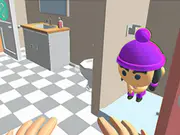Do Not Open
About Do Not Open
There’s a certain kind of dread, a deliciously unsettling chill, that only a truly captivating escape room game can deliver. And believe me, *Do Not Open* doesn’t just deliver; it absolutely wallows in it. From the moment the screen flickers to life, you’re not just playing a game; you’re trapped within a claustrophobic nightmare, driven by a desperate need to unravel the mysteries that hold you captive. It’s this intoxicating blend of puzzle-solving and psychological torment that has kept me – and countless others – completely hooked on *Do Not Open* for hours on end.
About Do Not Open
*Do Not Open game* thrusts you into the tormented mind of Michael J. Rooker, a zoologist tormented by unsettling premonitions about his wife and daughter. Waking up within his own eerily familiar yet undeniably sinister home, Michael quickly realizes he’s become ensnared in a nightmarish loop, his only escape seemingly tied to solving a series of increasingly intricate and unsettling puzzles scattered throughout the house. What distinguishes *Do Not Open* is its unique blend of procedurally generated puzzles and escape room mechanics. Each playthrough offers a distinct layout and puzzle combination, ensuring a genuinely unpredictable and fearfully exciting experience. The goal remains the same – escape before the malevolent forces consume you entirely – but the path to salvation is forever shrouded in uncertainty.
Unlike many horror games that rely on jump scares, *Do Not Open* cultivates a persistent atmosphere of dread. The creaking floorboards, the unsettling whispers that permeate the air, and the ever-present sense of being watched create a palpable tension that never truly lets up. This psychological horror is further amplified by Michael’s deteriorating mental state, blurring the lines between reality and nightmare as you delve deeper into his tormented psyche. The immersive sound design and chilling visuals work in perfect harmony to craft an experience that burrows deep under your skin, making *Do Not Open* far more than just another *Popular game* – it’s a psychological odyssey.
Playing *Do Not Open* is more than just solving puzzles; it’s about surviving. You’ll find yourself meticulously examining every nook and cranny of the Rooker household, desperately searching for clues and tools that might aid in your escape. The puzzles themselves are intricately designed, often requiring a combination of logic, observation, and a willingness to embrace the game’s unsettling atmosphere. It’s a constant battle against time and madness, as you struggle to piece together the fragments of Michael’s broken memories and uncover the dark secrets that lie hidden within the walls of his seemingly ordinary home. Each successful puzzle provides a small glimmer of hope, but the threat of failure – and the consequences that come with it – are always lurking just around the corner.
How to Play Do Not Open
To truly *play Do Not Open*, you need to embrace the chaos. The core of the game revolves around exploration and puzzle-solving, driven by intuitive yet demanding controls. Movement is navigated using the WASD keys (W to walk forward, A and D for strafing left and right, S to walk backward), allowing you to meticulously explore the labyrinthine corridors of Michael’s home. The mouse is your primary tool for interaction; aiming the cursor allows you to highlight objects of interest, and a simple left-click initiates interaction. This interaction might involve picking up an object, examining it closely, or attempting to use it on something else.
Specifically, when an object is highlighted with a glowing outline, a single left-click will pick it up. Once in your inventory, bringing up the inventory screen is done by tapping the ‘I’ key. From here, you can examine the object more closely by right-clicking, rotating it with the mouse wheel to find hidden clues or combinations, and attempting to combine it with other items by dragging one onto another. The success of these combinations is key to progressing through the game. For example, you might find a rusty key and need to locate oil (found elsewhere in the environment) to lubricate it before it can be used to unlock a specific door. Pay attention to the object’s description on screen. Often it will have a cryptic clue to what it opens or is needed for.
Navigating the environment isn’t just about walking around; it’s about paying attention. Michael can interact with objects to a limited degree, such as opening drawers (left-click on the handle) or flipping light switches (same principle). The game features a stamina system, represented by a bar at the bottom of the screen. Running (holding Shift while moving) consumes stamina, and if you run out, Michael becomes vulnerable. In some sections, enemies appear. The ‘C’ key allows you to crouch to evade these creatures. Stealth is paramount. When in direct line of sight, you will be grabbed and thrown down, losing stamina. This also progresses the overall game time.
The main objective in *Do Not Open* is, of course, to escape. This is achieved by solving a series of increasingly challenging puzzles, many of which require you to find hidden objects, decipher cryptic clues, and manipulate the environment. Secondary objectives often involve uncovering fragments of Michael’s past, piecing together the events that led to his current predicament, which gives clues to the larger picture. As a beginner, a vital tip is to be methodical. Check every single drawer, bookshelf, and container. Listen carefully to audio cues – they often hint at nearby secrets. Furthermore, don’t be afraid to experiment! Try combining different items, even if the connection isn’t immediately obvious. The game rewards curiosity and resourcefulness.
What Makes Do Not Open Special
*Do Not Open* distinguishes itself from other horror titles through a unique fusion of gameplay mechanics and atmospheric tension. Here are some standout features that set it apart:
- Procedural Puzzle Generation: Ensures a fresh and unpredictable experience with each playthrough, eliminating memorization and promoting genuine problem-solving.
- Intricate and Challenging Puzzles: Puzzles are carefully designed to test your logic, observation skills, and willingness to think outside the box.
- Psychological Horror Atmosphere: The game emphasizes dread and unease over jump scares, creating a persistent sense of paranoia and claustrophobia.
- Immersive Sound Design: Creaking floorboards, unsettling whispers, and other subtle audio cues heighten the tension and create a truly immersive experience.
- Detailed Environment: The Rooker household is meticulously crafted, with a wealth of detail that rewards careful exploration.
- Inventory Management: Managing your limited inventory space is crucial for survival, forcing you to make difficult choices about what to keep and what to discard.
- Limited Stamina: The stamina system adds an extra layer of tension, forcing you to conserve your energy and avoid unnecessary risks.
- Compelling Narrative: Unraveling the mysteries of Michael’s past is a driving force behind the gameplay, adding depth and emotional resonance to the experience.
- Multiple Endings: Your choices throughout the game can impact the ending, encouraging multiple playthroughs to discover all possible outcomes.
- High Replay Value: The procedural puzzle generation, multiple endings, and challenging gameplay ensure that *Do Not Open* offers hours of replayability.
These features, combined with the game’s unsettling atmosphere and compelling narrative, create a truly unforgettable and addictively challenging experience. *Do Not Open* isn’t just about solving puzzles; it’s about confronting your fears and pushing your mental limits.
Mastering Do Not Open
Becoming a true master of *Do Not Open* requires more than just basic knowledge; it demands a strategic approach and a keen understanding of the game’s inner workings. Here are some advanced tips to help you elevate your gameplay:
- Map Awareness: Create a mental map (or physical notes) of the house layout as you explore. Knowing the location of key rooms and items can save precious time.
- Prioritize Exploration: Thoroughly explore each area before focusing on a specific puzzle. Hidden items and clues are often scattered throughout the environment.
- Conserve Stamina: Avoid unnecessary running, especially in areas where enemies might be present. Conserving stamina can be the difference between life and death.
- Listen Carefully: Pay close attention to audio cues, as they often hint at nearby secrets or dangers. The sound of dripping water might indicate a hidden passage, while a faint whisper could warn you of an approaching enemy.
- Experiment with Combinations: Don’t be afraid to try combining different items, even if the connection isn’t immediately obvious. The game often rewards creative problem-solving.
- Manage Inventory Wisely: Carefully consider which items to keep and which to discard. Limited inventory space forces you to make difficult choices.
- Decipher Codes and Symbols: Many puzzles involve codes and symbols. Take notes and look for patterns to decipher their meaning.
- Utilize Stealth: When encountering enemies, prioritize stealth over direct confrontation. Crouching and moving slowly can help you avoid detection.
- Pay Attention to Environmental Storytelling: Examine the environment for clues about Michael’s past and the events that led to his current predicament.
- Learn Puzzle Patterns: While the puzzles are procedurally generated, certain patterns and logic principles tend to repeat. Learning these patterns can help you solve puzzles more quickly.
Furthermore, some players have discovered that specific actions, like examining certain objects in a specific order, can trigger hidden events or unlock secret areas. Keep an open mind and be willing to experiment to uncover all of the game’s secrets.
Different Ways to Play
*Do Not Open* is, at its core, a single-player experience focused on unraveling a chilling narrative. While there aren’t distinct “game modes” in the traditional sense, the game offers various difficulty levels that dramatically alter the experience. The “Easy” mode provides more hints and a less aggressive enemy presence, ideal for newcomers. “Normal” offers a balanced challenge, while “Hard” ratchets up the difficulty with fewer hints, more relentless enemies, and a heightened sense of paranoia. Each difficulty level impacts the availability of resources and the frequency of enemy encounters, significantly impacting the player’s strategic approach.
Beyond the difficulty settings, the procedural puzzle generation ensures high replay value. Because each playthrough presents a unique layout and puzzle combination, no two experiences are ever exactly alike. This encourages players to return to the game multiple times, mastering different strategies and uncovering new secrets. The game also includes multiple endings, dependent on player choices throughout the experience. Thus, *Do Not Open online* is a constant source of fresh excitement!
What Makes This Game Addictive
The addictiveness of *Do Not Open* stems from its masterful manipulation of the player’s psychology. The constant sense of dread, the challenging puzzles, and the compelling narrative create a feedback loop that keeps players hooked. Each successful puzzle provides a small dopamine rush, while the threat of failure motivates players to keep pushing forward. This psychological tug-of-war, combined with the game’s high replay value, makes it incredibly difficult to put down.
Beyond the mechanics, the community buzz surrounding *Do Not Open* contributes to its allure. Online forums are rife with players sharing their experiences, discussing strategies, and unraveling the game’s deeper mysteries. “I was terrified, but I couldn’t stop playing!” exclaims one avid fan. “The puzzles are so clever, and the atmosphere is just incredible. I’ve played it multiple times, and I’m still finding new things!” It’s the shared experience of overcoming the game’s challenges that fosters a sense of community and keeps players coming back for more.
Is Do Not Open Right For You?
*Do Not Open* is ideally suited for players who enjoy psychological horror games with a strong emphasis on puzzle-solving and exploration. Fans of titles like the *Silent Hill* series or the *Resident Evil* franchise will likely appreciate the game’s atmosphere of dread and its focus on unraveling a complex mystery. The game is rated Mature due to its unsettling themes and occasional moments of violence, so it’s not recommended for younger audiences.
However, even players who typically avoid horror games might find *Do Not Open* to be a rewarding experience. The game’s emphasis on puzzle-solving and its compelling narrative make it more than just a scare-fest. The learning curve can be steep, especially on higher difficulty settings, but the satisfaction of overcoming the game’s challenges is immense. If you’re looking for a game that will challenge your mind and test your nerves, *Do Not Open* is definitely worth checking out.
Why You Should Play Do Not Open Today
In a market saturated with generic horror games, *Do Not Open* stands out as a truly unique and unforgettable experience. Its blend of procedural puzzle generation, psychological horror atmosphere, and compelling narrative creates a game that is both challenging and deeply rewarding. It’s an experience that will test your limits, challenge your perceptions, and leave you questioning what’s real and what’s not.
If you’re looking for a game that will truly immerse you in a world of dread and mystery, look no further. *Do Not Open* offers an experience unlike any other, a journey into the tormented mind of Michael J. Rooker that you won’t soon forget. Dare to step inside, unravel the mysteries that await, and discover whether you have what it takes to escape. Don’t just read about the terror – experience it firsthand! Go *play Do Not Open* now and prepare to have your sanity tested.







